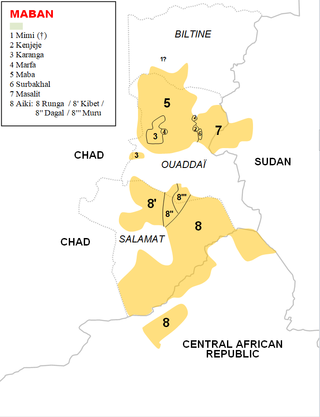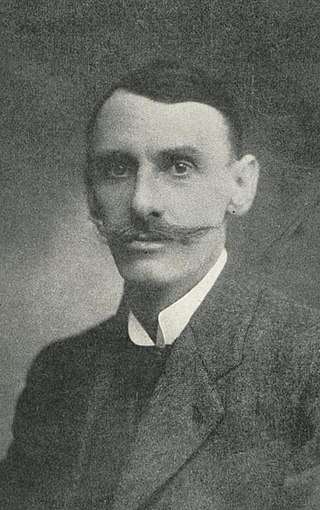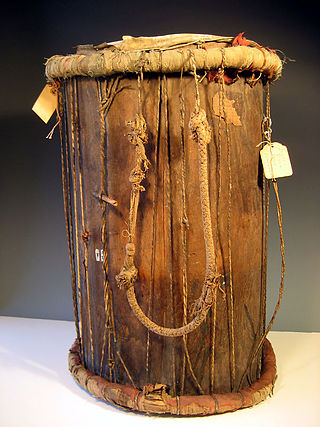Related Research Articles
The Bua languages are a subgroup of the Mbum–Day subgroup of the Savanna languages spoken by fewer than 30,000 people in southern Chad in an area stretching roughly between the Chari River and the Guéra Massif. They were labeled "G13" in Joseph Greenberg's Adamawa language-family proposal. They are ultimately part of the Niger–Congo family, and have exerted a significant influence on Laal.

Wadi Fira is one of the 23 regions of Chad. Its capital is the town of Biltine. The region corresponds with the former prefecture of Biltine.

The Maban languages are a small family of languages which have been included in the hypothetical Nilo-Saharan stock.
Day is an Adamawa language of southern Chad, spoken by 50,000 or so people southeast of Sarh. Ethnologue reports that its dialects are mutually intelligible, but Blench (2004) lists Ndanga, Njira, Yani, Takawa as apparently separate languages.

The Government of Chad has been ruled by Mahamat Déby since 20 April 2021 as part of the National Transitional Council.

Ouaddaï or Wadai is a region of Chad, located in the south-east of the country, with its capital at Abéché. Prior to 2002 it was known as Ouaddaï Prefecture; in 2008 the southern portions of Ouaddaï were split off to become the new Sila Region.
Kanembu is a Nilo-Saharan language spoken in Chad by the Kanembu people. It is also spoken by a smaller number of people in Niger. It is closely related to Kanuri.
Marba is an Afro-Asiatic language spoken by the Azumeina peoples of Chad as their first language. It is also the name of one of the Azumeina peoples.

Maurice Delafosse was a French ethnographer and colonial official who also worked in the field of the languages of Africa. In a review of his daughter's biography of him he was described as "one of the most outstanding French colonial administrators and ethnologists of his time."
Zaghawa is a Nilo-Saharan language spoken by the Zaghawa people of east-central Chad and northwestern Sudan (Darfur). The people who speak this language call it Beria, from Beri, the endonym of the Zaghawa people, and a, Zaghawa for "mouth". It has been estimated that there are about 447,400 native speakers of the Zaghawa language, who primarily live in Chad and the Darfur region of Sudan. It is also spoken by a smaller number of speakers in Libya.
Bidiyo is an Afro-Asiatic language spoken in south central Chad.
Dangaléat is an Afro-Asiatic language spoken in central Chad. Speakers make up the majority of the population of Migami Canton in Mongo, Chad.
Migaama is an Afro-Asiatic language spoken in central Chad. Speakers make up the majority of the population of Bang Bang, Chad.
Mubi is an Afro-Asiatic language spoken in central Chad. It forms one of the Mubi languages, a group of East Chadic languages.
Mokilko, or Mukulu, is a Chadic language spoken in central Chad. The local name for the language is Gergiko. This is the name used for mother-tongue literacy materials. Mukulu is the name of a village.
The Bongo–Bagirmi or Sara–Bongo–Bagirmi (SBB) languages are the major branch of the Central Sudanic language family with about forty languages. Principal groups include Bagirmi languages such as Naba and the Sara languages. They are spoken across CAR, Chad, South Sudan, Sudan and adjacent countries.
Maba is a Nilo-Saharan language of the Maban branch spoken in Chad and Sudan. It is divided into several dialects, and serves as a local trade language. Maba is closely related to the Masalit language. Most speakers of Maba reside in Chad with 542,000 speakers as of 2019. In 2022 there were 28,000 speakers in Sudan where the language is known as Sulaihab.
Maad a Signig Kumba Ndoffene Famak Joof was the King of Sine in modern-day Senegal. Maad a Sinig means king of Sine. He ruled from 1853 until his death on 23 August 1871. He was the son of Maad Souka Ndela Joof and Lingeer Gnilane Jogoy Joof. His father – Maad Souka Ndela came from The Royal House of Semou Njekeh Joof founded by Maad Semou Njekeh Joof in the early 18th century, which was the third and last Royal House of Joof family of Sine and Saloum. His paternal family ruled three Kingdoms : Sine, Kingdom of Saloum and previously the Kingdom of Baol. They descended from Maad Ndaah Njemeh Joof the 13th century King of Lâ (Laah) in Baol.

The Battle of Fandane-Thiouthioune, also known as the Battle of Somb or the Battle of Somb-Tioutioune, occurred on 18 July 1867. It was a religious war between the Serer people and the Muslim Marabouts in 19th-century Senegal and the Gambia, but it also had a political and economic dimension to it: vendetta and empire-building. Fandane, Thiouthioune and Somb were part of the pre-colonial Serer Kingdom of Sine, now part of independent Senegal.
This is a timeline of the history and development of Serer religion and the Serer people of Senegal, The Gambia and Mauritania. This timeline merely gives an overview of their history, consisting of calibrated archaeological discoveries in Serer countries, Serer religion, politics, royalty, etc. Dates are given according to the Common Era. For a background to these events, see Roog, Serer religion, Serer creation myth, Serer prehistory, Lamane, States headed by Serer Lamanes, Serer history and Serer people.
References
- 1 2 Marfa at Ethnologue (25th ed., 2022)
